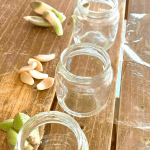Introduction
Tiny Gardening, also known as micro-gardening or dwarf gardening, is a recent trend in landscaping. It involves using potted plants, small containers and other miniaturized items to create an outdoor landscape design that fits into even the smallest outdoor space. Because of its small scale and aesthetic charm, tiny gardening is an attractive option for apartment dwellers, people with limited outdoor areas or those who just want some greenery without taking up too much room.
Getting started with tiny gardening is easy. Begin by assessing the space you have available to work with – this will help you determine the types of plants and accessories you can comfortably fit into your area. Consider its lighting options (such as natural sunlight and artificial lighting), potential water drainage issues, soil type and more when choosing your plants. Many people opt for smaller flowering plants as they require less maintenance than larger plants and trees; climbing vines make great use of vertical space too. Utilize planter boxes to create raised beds that help prevent weed growth while adding visual interest. Additionally, consider container gardening by planting different types of vegetables in various pots that can be easily relocated to another spot if needed. Finally, accessorizing your tiny garden area with meaningful objects such as garden statues or wind chimes helps capture a unique personality for each individual space.
Creating the Perfect Tiny Garden Design
Tiny Gardens come in all shapes, sizes, and styles—so it can be tricky to choose the perfect tiny garden design for your space. The key is to consider which plants and design elements best fit your landscape and home style. Whether you’re working with a small patio or an extra-long balcony, there are plenty of ways to cultivate your miniature ecosystem while maximizing limited outdoor space.
When designing a tiny garden, one must first decide the type of garden they want: edible, ornamental, practical or aesthetic? The following steps can help create a successful design that is as unique as you are:
1. Assess the environment – Start by assessing the environment, such as amount of light (direct sun versus shade) and soil type; this will help you decide what kinds of plants to choose.
2. Choose plants that are appropriate for the space – Before picking out plants for your tiny garden design, make sure the plants you select are suitable for your climate zone and can thrive in your particular environment conditions.
3. Don’t forget pots – Pots provide excellent opportunities for outdoor greenery without taking up much space. Consider repurposing items from around the house, like bicycle baskets or galvanized buckets.
4. Use vertical gardening – Vertical gardening allows for maximum potential with limited horizontal square footage due to its vertical shape; some great options include wall planters, hanging baskets and trellises that can be used to grow vines and climbing flowers.
5. Incorporate furniture – Adding furniture into a teeny garden design creates both a practical space to enjoy nature as well as an attractive setup —you don’t have to go big here; items such as chairs made from recycled materials work just fine if there isn’t much physical space!
6. Accessorize thoughtfully – Finally, accessorize with thoughtful touches like wind-chimes or bird baths for more interaction between nature Animal sculptures or even living foods like herbs also make pleasant additions to landscape designs and encourage visitors who may not ordinarily interact with wildlife at ground level!
Analyzing Your Existing Space to Maximize Potential
Tiny gardening can be an opportunity to maximize potential in a limited space. To get started, first analyze your existing space—measure and map it out, if you can. You might even take photographs. Once you have determined the dimensions of the space, determine what kind of plants you would like to include and decide where they should go. Consider which areas may contain more or less sunlight during different times of day or year. Lastly, strategically plan pathways and seating areas so that the garden is pleasant and easy to access and enjoy. Utilizing the existing elements within the space such as structures, walls, trees, and walkways can help create cozy corners or an intimate atmosphere while also increasing usage potential without taking up extra space. With some thoughtful planning and design ideas, tiny gardens can become beautiful respites and nature-filled havens even in small spaces!
Knowing the Tools and Supplies You Need
Tiny gardening is a great way to add vibrant life to any space. It is affordable, accessible and allows individuals of all ages and skill levels to get involved. Before you start small-scale gardening, it is important to know what tools and supplies you need.
For the basics, small gardeners will need supplies such as pots and soil, plant markers or labels for identification, as well as pruners for deadheading flowers and trimming back branches when needed. Depending on the type of plants being grown, additional tools may be necessary, like watering cans or hoses for larger containers.
Gardening gloves are also important – not only do they help protect the hands from scratching or getting dirt underneath fingernails but they also keep them clean from any chemicals like fertilizer that may be present on the ground. To make sure your plants stay healthy, be sure to have an appropriate amount of sunlight for your specific type of plants too! Spades are helpful in smaller containers if mixing soil with some compost or other nutrient rich material is needed before planting. Lastly, it’s essential to pick pest-resistant plants so they’ll last much longer!
Delving Into the Different Types of Tiny Gardens
Tiny Gardening is an emerging trend that allows gardeners of all experience levels to explore their creative sides and build beautiful, lush gardens in small spaces. While small garden designs usually measure no more than 500 square feet, tiny gardening takes this concept a step further and can be defined as gardening within a space of 200 square feet or less. This style of gardening usually involves using container plants, window boxes, vertical hanging gardens, raised beds, and other similar techniques to maximize the limited space available for planting.
One popular type of tiny garden is called an urban oasis. This type of garden often includes greens like herbs or microgreens and typically uses both containers and vertical hangers. Urban oases are perfect for balconies or patios with limited space and often feature potted succulents or other drought tolerant plants which are hardy enough to thrive in the sometimes harsh city environment.
Another type of tiny garden is known as miniature gardens. These gardens involve creating scaled-down details such as rocks, pathways, bridges, statues, fountains, ponds or any number of other decorations which allow themers to let their imaginations run wild. Miniature gardens also require careful selection of plants and use a variety of species that can fit in containers without overcrowding the space.
The final type of tiny garden is containerscape gardening. This form uses primarily containers such as pots, tubs or baskets to create a visually striking combination of flowers and foliage in tight quarters where none might otherwise exist. Containerscapes often feature combinations of annuals for color combined with evergreens for texture along with climbers which add further depth to the design without overcrowding it.
Producing Healthy and Delicious Harvest With Tiny Gardens
Tiny gardening is a great and sustainable way to produce healthy and delicious produce with limited space. By utilizing different solutions, like container gardening or vertical gardening, you can create a mini garden even in the smallest of spaces. Tools such as trellis systems, hanging gardens, or unique planters can be used to fit your growing needs. Plus, with urban farming becoming increasingly popular, tiny gardens are a fantastic way to have access to fresh food in even the most constrained situations.
Container gardening is an ideal solution for those wishing to pursue tiny gardening in cramped spaces such as patios or balconies. Potting soil specially designed for container gardens allows plants to thrive without requiring vast amounts of soil and permits them to still absorb enough water. Additionally, containers come in many shapes and sizes allowing avid gardeners the flexibility they need while tending their garden. Pots differ greatly both in materials and cost range also giving every gardener chance to tailor make a system fitting their fancy bag.
Vertical gardening enables users with limited space the ability to get the maximum yield from their garden by taking advantage of unused wallspace. Vertical gardens use modern technologies such as hydroponics, aquaponics and aeroponics which reduce environmental waste whilst producing dense foliage for fresh cuttings throughout the year. For those looking more into sustainability there are numerous designs ranging from self-watering systems to open-source carpentry plans that simplify building your own green wall at home!
Finally, tiny gardening gives hobbyists access to an array of custom tools aimed at helping them curate their harvest despite having limited square footage. Stackable planters provide ample room for vining vegetables like tomatoes or squash while trellises offer a small footprint solution increasing outdoor living space even further by letting you grow vertically on walls or fence posts. Moreover, cold frames keep temperatures regulated for winter planting mitigating environmental threats such as unexpected frosts; protecting delicate species and guaranteeing you will enjoy fresh harvests throughout all seasons!
Crafting Your Own Way To Tiny Gardening Success
Tiny gardening is an emerging trend that offers individuals the opportunity to create their own miniature oasis of green. This type of growing allows homeowners or renters to successfully cultivate a garden with limited space and resources. One way to get started is by researching what species of plants are suitable for your climate and area. From herbs, vegetables, flowers and trees, there are many different options to choose from that can fit into tight spaces and won’t take up too much room.
When choosing plant varieties for tiny gardening it is important to consider the environment you have available. Different plants will require different amounts of sunlight, water and nutrients in order to thrive. Many small plants are drought resistant making them ideal for areas with restricted water access or budget constraints. Additionally, some plants might be better suited for window boxes than ground planters depending on the size and amount sun exposure needed.
Once you’ve chosen your plants it’s time to create a design plan and get down to work! If you want a more professional look then raised beds or terraced plantations may be just the thing. Alternatively, if you’re all about repurposing old items think about how discarded buckets or reused wood can be turned into planters!
Using vertical elements like trellises and climbing vines can also help maximize the space in tiny gardens while allowing their roots spread outwards instead of downwards In addition, utilizing seasonal décor such as blankets or tablecloths will further enhance your outdoor décor while protecting your tiny garden from the elements when not in use. Finally, although it might seem like an added expense don’t forget about adding lights and other features that offer safe nighttime illumination for enjoying your newly-made miniature oasis once night falls!
Avoiding Common Mistakes to Make Your Tiny Garden a Triumph
One of the biggest mistakes people make when attempting to create a tiny garden is not considering the sun and shade areas on their property. As with any planting environment, you’ll need to note how much sunlight each area receives and consider what type of plants do best in those areas such as those that thrive in or prefer full shade or those who look down upon partial shade conditions. Another mistake is neglecting proper drainage which can be a problem especially in small spaces where it’s easy for water to become trapped which can lead to root rot and wrong choices of soil. It’s important to select soil that is well-aerated so that air circulation isn’t hindered and it also helps to add amendments such as compost prior to planting for ideal nutrient absorption and microbial activity. Finally, most novice gardeners forget about the pests that can devastate their miniature masterpiece. Being vigilant about checking for signs of disease, weeds, molds, mildews, etc., will ensure an amazing outcome for your tiny garden!
Wrap-Up
Tiny gardening is the perfect way to start gardening if you are short on space, time, or resources. No matter how small your plant may be, it will still have a big impact on the environment and your life. With an understanding of the basics, as well as some clever creativity, you can easily design a thriving tiny garden. You can choose from a wide selection of plants and adorn it with decorative items like statues and fairy garden accessories to make it even more magical. Best of all, you don’t need experience or even land to get started!
Take action now to begin creating your own tiny garden! Start by stocking up on essential supplies like soil, containers, plants and decorations that work for your living space. Figure out what type of layout appeals most to you—traditional rows or a more eclectic mix of plants—and create a miniature version in your home or balcony. If possible, choose a spot that receives at least six hours of sunlight each day; it will do wonders for fostering growth in your tiny garden. Water your plants regularly — usually two times per week–and watch how they burst with life in no time at all. Finally, embrace cleanup and maintenance as part of the enjoyable responsibilities associated with maintaining a healthy mini-ecosystem!

Welcome to my gardening blog! I am passionate about plants and enjoy sharing my knowledge and experiences with others. In this blog, I will write about everything related to gardening, from tips on how to get started to updates on my own garden projects.





